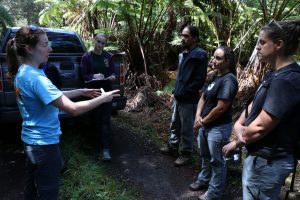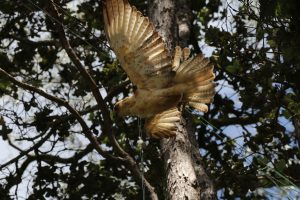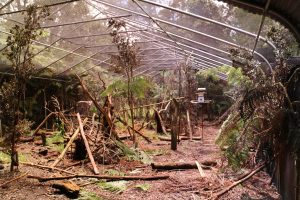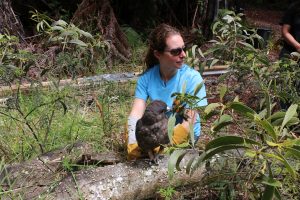Anti-Predator Training Prepares ʻAlalā Before Release

Dr. Alison Greggor instructs her team on the predator training exercise. PC: Dan Dennison, The ʻAlalā Project.

ʻAlalā birds in their flight aviary listen to recorded screeching of the Hawaiian Hawk. PC: Dan Dennison, The ʻAlalā Project.

Kapono flaps his wings with prey in his claws within view of the ʻAlalā groups in training. PC: PC: Dan Dennison, The ʻAlalā Project.
A team of researchers working under the ʻAlalā Project are seeing promising results in preparing a group of critically endangered ʻAlalā to avoid predators when they are reintroduced to the wild.
Led by Dr. Alison Greggor, the team has been closely observing the behavior of the birds within their aviary while recreating specific sights and sound cues given by the ‘Io (the Hawaiian Hawk)—also an endangered endemic bird and a known predator. Scientists have found that many animals, including the ʻAlalā, cannot recognize their predators if they have no one to learn from.
“These birds, raised in captivity, have never encountered predators in the wild, or had the chance to learn from their parents or their peers about the dangerous predators in their own backyards,” said Dr. Greggor. “We provide that learning opportunity by mimicking biologically relevant scenarios that they’d get had they been born in the wild.”
The ʻAlalā (or Hawaiian crow) is an endemic Hawaiian forest birds that has been extinct in the wild for over a decade. The last wild crows were seen in South Kona more than 15 years ago.
The training lasts less than 25 minutes, observing how the birds act before and after predatory stimuli are introduced and capturing their behavior on video. At the 18-minute mark, the action begins with the sound of a prerecorded ‘Io screeching accompanied by a stuffed ‘Io carried over the aviary on a pulley system. Next, the team plays ʻAlalā alarm calls to indicate something is wrong followed by a visual introduction of Kapono, the Panaʻewa Rainforest Zoo’s resident ‘Io.
“The alarm calls communicate, danger, danger, danger,” explained Greggor. “While the recording plays we present Kapono in a side chamber of the aviary. He flaps his wings and then we start playing distress calls that go from the danger alert to help me, help me, help me. At that point, a stuffed American Crow is put under the ‘Io’s feet so we complete the full picture from the approach of a predator to a full-on perceived attack.”
“The various angles from the video cameras provide invaluable insights to the pre-and post-behaviors of the entire group and of individual birds,” said Rachel Kingsley, an education and outreach associate for the ʻAlalā Project who operated one of the cameras during the training. “At first glance, it appears the cohort responded to predator sights and sounds strongly . . . just what we want to see happening before these highly intelligent creatures are released into the forest.”
Predator recognition and aversion tactics have been used by other reintroduction efforts, especially those involving the release of captive animals with no knowledge of predators.
The ʻAlalā Project, a collective of government and non-government organizations, has been working to restore a self sustaining, breeding population of crows for reintroduction to their native forest homes. Partners in the project include the San Diego Zoo Global’s Hawai‘i Endangered Bird Conservation Program, the Hawai‘i Department of Land and Natural Resource’s Division of Forestry and Wildlife and the U.S. Fish and Wildlife Service.
One year ago, 11 ʻAlalā were reintroduced into a designated natural area reserve (NAR) where they are currently thriving. In late September and again early in October, two separate groups of the birds will be released at different locations in the NAR.




















